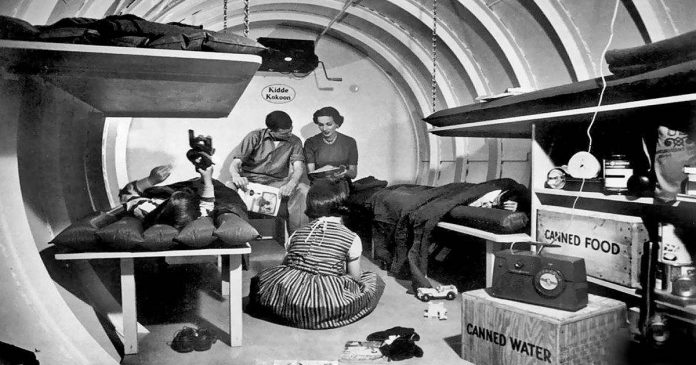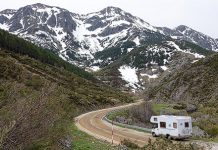Anyone who likes post-apocalypse films knows what a house that has been subjected to a nuclear explosion looks like – broken walls blown down to a few feet high, burnt timbers and a fire-plated interior. The inhabitants’ skeletons may also be placed artistically over a mound of debris.
Pictures of Hiroshima and Nagasaki after they’ve been bombed show just that kind of complete devastation, and it’s common for many people to be fairly resigned to nuclear war.
If they can cause that sort of devastation, surely there’s no chance of survival anyway? Isn’t it better to just get it over with quickly?
In a word, no.
The blast from a nuclear bomb is extremely intense but it also obeys the laws of physics; when you step away from the exact core of the explosion – Ground Zero, the strength of the destruction drops off rapidly. This also does not fall in a straight line, but is essentially following the inverse square law. This simply means the gun’s effects decrease by the distance square from Ground Zero; if you’re twice as far away the effects will be around a quarter as destructive, and if you’re three times as far away they’ll be one-ninth as destructive.
These figures aren’t rock solid, and can vary depending on the height the weapon explodes at and the shape of the ground, but they’re a pretty good rule of thumb. And with a very large arsenal, for the degree of damage to fall from absolute to survivable, you don’t have to be too far away from it – and even in a full-scale attack, massive parts of the country will completely avoid the immediate impact. So if the risk of a nuclear attack increases, unless you live in a major city or right next to a strategic target, it’s definitely worth having your home prepared to give it – and you – the best chance of survival.
If you’re going to prepare for a nuclear attack, first you need to know what the dangers are. When the warhead detonates there are basically five ways it can kill you:
- Thermal pulse – A very intense flash of heat and light
- Blast – Overpressure and high winds
- Prompt radiation – A pulse of X-Ray and gamma radiation
- Residual radiation – Alpha and beta radiation released by the ground around Ground Zero
- Fallout – Radioactive particles scattered by the explosion
Forget about the prompt radiation in the first place. It is a single brief pulse, lasting a few seconds, and the inverse square law detracts from its power. Unless you’re about 3,000 yards from the blast you’re not going to pick up a harmful exposure. In other words, unless it is a very small device, the thermal pulse or explosion would have already killed you even if you are close enough to have to think about prompt radiation.
Residual radiation is more of a concern but it is one that is easily avoided. If a nuke sets off on the atmosphere, or in the air but small enough to reach the surface with a strong gamma pulse, the earth itself becomes radioactive. It emits alpha particles, which a gas mask and heavy clothing can avoid, and more dangerous beta particles which penetrate a vehicle’s body. Residual radiation can be dangerous weeks after the blast. Luckily you don’t need to be subjected to it. Just don’t go near craters or areas of complete destruction.
And we have three things to guard against: thermal pulse, blast and fallout. You can make your home far more resistant to all of these with the right preparation. Here’s how to go about it.
Thermal pulse
A nuclear bomb emits massive quantities of energy and about one third of that comes out as radioactive radiation. This radiation spans a broad range, ranging from gamma and X-ray to UV, radio wave, visible light and infrared, and it is highly intense. All this energy generates plenty of heat; something close to the explosion will heat up enough to turn it into plasma, and even eight miles from a one-megaton airburst the energy strength is high enough to cause third-degree burns. That’s obviously enough heat to start fires, too, so when you get closer to the blast, the risk will increase geometrically. If you take the right precautions, the good news is that your home will be protected from fire at a distance from where an unprepared one would burn.
Next, clear off flammable stuff from around your house. Dead foliage can flare up quickly and spread sparks; even if your house isn’t burned down by the flash from the weapon, burning leaves might. Inside, remove anything flammable from windowsills and check your curtains. Light or net curtains need to be taken down, but if you have thick, lined curtains keep them up and closed-if the windows break, they will help protect against flying glass.
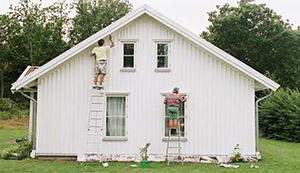

Next, get some white emulsion paint, and give a coat to the outside of all your windows. People are laughing about this advice but it can make a huge difference. White paint represents much of the energy of the pulse and keeps it out of your home; without it there is a very high chance of fires starting from inside. Many say the blast destroys the windows anyway, but they’re wrong. First, the thermal pulse will start fires much farther away than the blast would smash windows, under the right conditions. Second, the blast wave is very fast — the shock front can spread outward at more than three miles per second — but the thermal pulse moves at light speed. But if the blast comes before the flash fades, you can still hold out a lot of the thermal energy.
If you have a little more time, paint as much white as you can on your room. Start on walls facing possible nuclear targets-do that side first if there’s an airbase five miles away. Your goal here is exactly the same; reflect as much thermal radiation as you can. Any bit of energy that you can pull back from your walls reduces the chance of a burn.
Pick out as many water or sand buckets and fire extinguishers as you can. Keep your fallout room (we’ll think about that soon). Cover buckets of water; that way you can also use them for drinking. Eventually, if you hear a warning of an attack or have to leave home for a while, turn off the gas and electricity at the mains. This will reduce the risk of fire-causing harm.
Related: A Step-by-Step of What to Do After an EMP Attack
Blast
Blast is one of the most difficult effects to defend against. The shock front of the explosion will bring along with it a fast-moving wave of highly compressed air; near the explosion this travels at three or four times the sound level, and it is very damaging. The good news is human bodies can withstand overpressure up to around 30psi, and the thermal pulse would almost certainly vaporize anything near enough to encounter that level of pressure. The bad news is that even large concrete buildings do not withstand well above 20psi and 5psi is enough for the average home to collapse. You are much more blast-resistant than your house, but that won’t help if it collapses on you. Most fatalities from blast will be indirect, and caused by collapsing buildings.
There are also a few things you can do. Heavy curtains are slowing or preventing flying glass, which can save you from injuries if a weapon explodes before you get to your fault spot. When you can, cut down any trees that could fall on your house – and if they do fall on it, they’re pretty much sure to get nuclear blast. Clear off loose objects from outside. Clear away loose items from outside. Trash cans or bikes, picked up by the blast and slammed into the front wall of your house, can make the difference between it making it through the explosion or collapsing on top of you. Lightweight wooden sheds or barns will go down at a much lower overpressure than your house so move anything vital out of them. Knock them down yourself if they are really flimsy; this is better than getting them turned into flying rockets.
As the blast wave’s overpressure falls on it, a rapid decrease in pressure occurs, another blast wave mirrored as air floods back into the low-pressure region behind the shock front. Which means stuff can be picked up from all directions and hurled at your house. The unexpected changes in pressure will suffice to actually cause certain buildings to collapse. Do not leave doors or windows open to try to avoid this; but, if the blast wave is strong enough to smash your room, it breaks the windows, anyway.
Related: 10 EMP Proof Items
Fallout
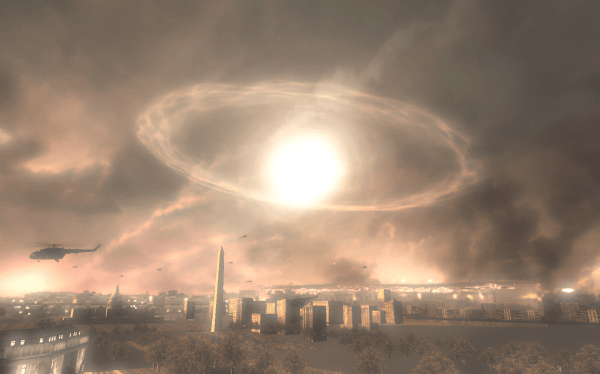

When a nuclear weapon explodes, it transforms only a small amount of its mass – a few pounds – into energy. The remainder, which can be up to a ton anywhere, is overheated by the reaction and converted into an extremely dry, highly radioactive plasma. Tons of dust and debris – as the fireball produced by the explosion hits the earth, thousands of tons – will be swept up through the fireball and mixed with the plasma, which will cool down and condense when the fireball dissipates.
All this dust – sprayed by radiation, mixed with bomb material and reduced to fine sand consistency – is blown up into the mushroom cloud and released as debris. The heavier particles will begin to fall downwind from Ground Zero within minutes of the blast; the lighter ones, depending on how high they are going, can be carried into the high-altitude winds of the stratosphere and descend almost anywhere in the world. The entire world would get a very light dusting of radiation within the two weeks following a nuclear attack.
Yet don’t give up on hope yet. Fallout will not remain dangerous forever. Its radioactivity falls according to rule 7/10 – for every seven-fold increase in time since the blast, radiation levels drop to a tenth of what they were:
- An hour after the explosion the fallout might be creating a radiation level of 1,000 roentgens per hour (R/hr); five minutes’ exposure to this is often enough to cause radiation sickness. Half an hour will kill about half the people who’re exposed, and everyone who’s exposed to it for an hour will be dead inside a few days.
- After another seven hours the radiation level will have fallen to 100R/hr;
- 49 hours later it’s down to 10R/hr.
- Two weeks after the attack it will be 1R/hr, and at that point you can be exposed for several hours a day without serious risk of radiation sickness.
- A year after the attack radiation levels will be close to normal background levels.
The Fallout Room
The trick to survival is obviously to escape the radiation until the initial intense radioactivity has diminished to a less harmful level. You need to plan a fallout room inside your home to do this. Ideally, this would be an enclosed space with no external walls. Second, stopping radiation from getting in on it is simpler. Secondly, any radiation from outside debris that penetrates the walls will lose intensity with distance – note the inverse square theorem – and will also be partially absorbed by walls and furniture. Use a room as far away from the roof as possible as there will be debris accumulating – and if it is destroyed, the lethal dust will get through. If you have a cellar, use that; it will be shielded almost completely from outside radiation.
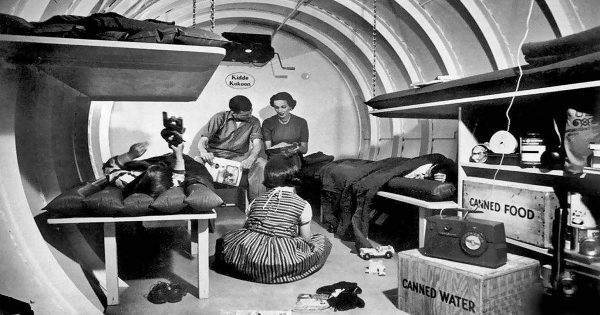

Many homes have no room with no external walls so you’ll have to improvise. If you can, choose a room at the downwind side, because less fallout will be blown up against the walls. Now seal the room as well as you can. Block in as closely as you can any door, air vents or other openings. Block up any windows, air vents or other openings as tightly as you can. Try not to just seal them with plastic sheet on the inside, because if any fallout gets through it’s going to be trapped between the plastic and the wall. Which ensures that any radiation from it would be with you in the room and you just have to keep it outside.
You’ll need to thicken the walls until the space is sealed. The biggest threat would be gamma radiation, which can be done across a few inches of wood or about an inch of aluminium. The more mass you can place between the runoff and yourself, the better. When you have the time and resources, reinforce the exterior of the outer walls to a height of six feet above the ground. A brick or cinder block coating is pretty fine. Sandbags are useful if you can’t do that – use stakes and wire to keep them in place so they can withstand blasting or stack them inside. Stacks of books can also remove beta particles, and bulky furniture may be used, too. Basically any thick, heavy material can absorb the radiation until it can enter your fallout room.
There are some things you should store in the fallout room, because two weeks after the attack you’ll be staying in there. The first thing you should eat is food, preferably cold stuff. So store as much water as possible in enclosed or at least protected containers – any debris that gets in can be stored by pouring in an uncovered bucket. Firefighting equipment and camping gear should be in your fallout room, as well as any comforts for which you have space.
You would also need either a chemical toilet or a bucket and a supply of strong garbage bags to suit it. Put two garbage cans, with lids, right outside the fallout room door; use one for toilet bucket bags, and use the other for the rest of your garbage.
One more thing to do. Within the fallout room, you need to create your inner refuge as far away from outside walls as possible. It is a small shelter, which is fully protected for optimum radiation protection. If you’ve got a large, big table you can use it as a foundation. Piling up large furniture, sandbags, books and anything else thick around it, covering it so it’s as sealed as possible and getting several boxes full of books or dirt that can be dragged in front of the entrance.
Related: 10 Survival Tricks You Did Not Think Of
If you don’t have a table, remove one or two doors-if you can take them upstairs-and prop them against the wall at 45°. Secure them by nailing a wooden strip to the floor to prevent them from slipping and cover them with books or sandbags. Again, h ave something blocking the entrance.
Get into your fallout room as quickly as possible after an attack, and into the inner refuge. Only leave the inner refuge when it is absolutely necessary, for at least 48 hours. During this time, radiation is at its highest and most likely there will be an elevated level inside the fallout room; stay as protected as possible.
You can spend more time outside the refuge after two days but don’t leave the fallout room. If you need to get rid of toilet waste or garbage just open the door as far as you can, drop the bag in the right trash can and immediately shut the door. Yet close it smoothly – don’t slam it shut. The last thing you want to do is stir up some particles, because some of it is going to be fallout. Live in the fallout room for at least two weeks, and longer if you can; sleep in the inner shelter, and if you don’t do anything go in there too. The more you are protected, the better.
Preparing your house seems like a lot of work but in two or three days you can do a pretty good job of it. That effort is worth it. Whether that two or three days is the difference between your house catching fire or not, you’re going to have a safe place to hide from the consequences. Do not prepare your home and there is a fair risk that you will be out there in desperate search of shelter when the radioactive dust begins to fall. When that happens, your chances of survival aren’t good-and when that’s your option, it doesn’t seem like the big job to plan your home to withstand the attack.



